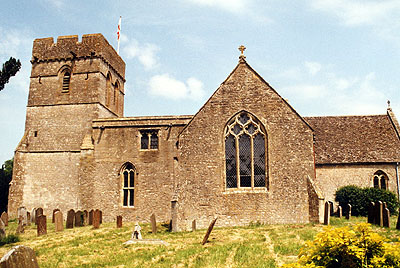 |
 |
|||
|
|
This church has much of interest. It is a fine example of an almost complete Norman church (with some later additions), particularly the very solid looking tower. There is still part of a late 12th century frieze of grotesques under the eaves. It must have been much like the celebrated version at Kilpeck in Herefordshire in its heyday. However, part of the walls and a small blocked doorway and scratch dial on the south side are in fact Saxon work. Upon entering, one is immediately struck by the unusual statue of Queen Elizabeth I, which originally stood in Cumnor Place. On the walls nearby are numerous carved corbels featuring smiling faces, one remarkably like Lewis Carol’s Cheshire Cat. The carved choir stalls are the best of the building’s fittings. Unfortunately there are no misericords. The pulpit is a double-decker one. The font looks like a magnificent medieval example, but was only carved in 1840! Behind it, access to the tower’s upper levels is via a most extraordinary 17th century spiral staircase. The large south chapel seems to have been owned by the old adjoining manor-house of Cumnor Place, long pulled down. It was the main country retreat of the Abbots of Abingdon and two of them are buried under the medieval arches in the chapel’s south wall, probably William de Cumnor (died 1334) and one of his successors. Shame about the profusion of stacked chairs in front of them. There are brasses to three Williams sisters, nieces of Queen Elizabeth’s Master of the Royal Jewels, Lord Williams of Thame, who lived at Wytham 'Abbey' amongst other places. One of these ladies lies under the large reused canopied monument to the left of the altar, with her husband, Tony Forster. His family came from Shropshire and were not related to the Forsters of Aldermaston. The couple were renting Cumnor Place (and later bought it) when the Earl of Leicester’s wife, Amy Robsart, visited in 1560. She was left alone there, while the rest of the household went off to Abingdon Fair. When they returned, she was found dead at the foot of the stairs. A comprehensive display board tells you everything you might need to know about Cumnor Place and Amy Robsart’s supposed murder. Out in the churchyard, a very small piece of carved stonework from the building can be seen near the old entrance to its courtyard. Sir William Wilson Hunter’s high Victorian alabaster monument was perhaps inspired by the Forster monument. However, it is the unassuming mural monument in the nave which hides a fascinating story of Georgian adventure. It remembers Norris Hodson, a probable descendant of Lord Williams’ daughter, Margery and her husband, Lord Norreys. He went to sea as a carpenter on board the ‘Gloucester’ in 1740 and died during the disastrous British expedition to harass the Spanish on the west coast of South America. The storms around the Cape were terrible and disease rife. Some ships mutinied, others lost between a third and a half of the crew. His full story has been researched by John Hanson and can be read on his excellent Cumnor History Website. This is not the official Cumnor Church website. Please do NOT mail me about use of the church. Visit the C of E's Church Near You website instead. |
|||
| © Nash Ford Publishing 2010. All Rights Reserved. The location of this church is now administered by Oxfordshire County Council. | ||||



 Cumnor
Cumnor